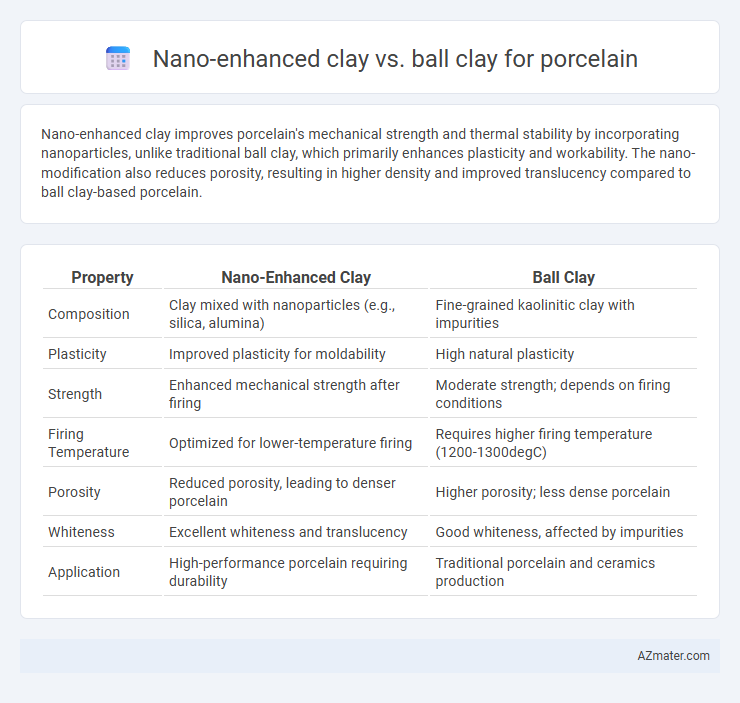Nano-enhanced clay improves porcelain's mechanical strength and thermal stability by incorporating nanoparticles, unlike traditional ball clay, which primarily enhances plasticity and workability. The nano-modification also reduces porosity, resulting in higher density and improved translucency compared to ball clay-based porcelain.
Table of Comparison
| Property | Nano-Enhanced Clay | Ball Clay |
|---|---|---|
| Composition | Clay mixed with nanoparticles (e.g., silica, alumina) | Fine-grained kaolinitic clay with impurities |
| Plasticity | Improved plasticity for moldability | High natural plasticity |
| Strength | Enhanced mechanical strength after firing | Moderate strength; depends on firing conditions |
| Firing Temperature | Optimized for lower-temperature firing | Requires higher firing temperature (1200-1300degC) |
| Porosity | Reduced porosity, leading to denser porcelain | Higher porosity; less dense porcelain |
| Whiteness | Excellent whiteness and translucency | Good whiteness, affected by impurities |
| Application | High-performance porcelain requiring durability | Traditional porcelain and ceramics production |
Introduction to Porcelain Clays
Porcelain clays demand exceptional purity and plasticity to achieve the desired translucency and strength in the final ceramic product. Nano-enhanced clay offers improved particle dispersion and finer particle size distribution compared to traditional ball clay, resulting in a denser and more uniform porcelain body. Ball clay, while highly plastic and widely used, contains higher impurities that can affect the whiteness and translucency critical for high-quality porcelain.
What is Nano-Enhanced Clay?
Nano-enhanced clay incorporates nanoparticles to improve the physical and chemical properties of traditional clay, offering superior plasticity, strength, and firing behavior compared to conventional ball clay. This advanced material enhances porcelain's translucency, whiteness, and density by promoting better particle packing and reduced porosity during the sintering process. In contrast, ball clay, primarily composed of fine-grained kaolinite and other minerals, provides excellent plasticity but lacks the nanoscale modifications that yield enhanced performance in high-quality porcelain production.
Understanding Ball Clay in Porcelain
Ball clay is a key component in porcelain production due to its high plasticity, fine particle size, and excellent binding properties, which contribute to the strength and workability of porcelain bodies. Nano-enhanced clay introduces nanoscale particles that can improve mechanical properties and reduce firing temperatures, but traditional ball clay remains preferred for its consistent plasticity and surface finish. Understanding ball clay's mineral composition, primarily kaolinite with mica and quartz, is essential for optimizing porcelain formulations and achieving desired translucency and durability.
Key Differences: Nano-Enhanced vs Ball Clay
Nano-enhanced clay contains ultrafine particles that improve porcelain's strength, translucency, and firing efficiency compared to traditional ball clay. Ball clay, known for its high plasticity and smooth texture, contributes to workability and shape retention but lacks the advanced mechanical benefits of nano-sized additives. The integration of nano-enhanced clay results in improved durability and reduced shrinkage, making it superior for high-performance porcelain applications.
Particle Size and Distribution Comparison
Nano-enhanced clay exhibits significantly finer particle sizes, typically below 100 nanometers, compared to ball clay particles that range from 0.5 to 50 microns. This ultra-fine particle distribution in nano-enhanced clay contributes to improved packing density and uniformity in porcelain bodies, resulting in superior strength and translucency. In contrast, ball clay's broader particle size distribution can lead to less consistent microstructure and increased porosity in porcelain products.
Impact on Porcelain Strength and Durability
Nano-enhanced clay significantly improves porcelain strength and durability by filling micro-pores and increasing particle bonding at the nanoscale, resulting in higher fracture toughness and resistance to crack propagation compared to traditional ball clay. Ball clay, while offering plasticity and smooth texture, lacks the nanoscale reinforcement needed for superior mechanical properties, often leading to higher porosity and lower structural integrity in fired porcelain. Incorporating nano-enhanced clay into porcelain formulations enhances overall wear resistance and longevity, making it ideal for high-performance ceramic applications.
Water Absorption and Plasticity
Nano-enhanced clay exhibits significantly lower water absorption rates compared to ball clay, enhancing the durability and vitrification of porcelain products. Its improved plasticity results from the refined particle size distribution, enabling superior workability and forming precision during shaping processes. Ball clay, while traditionally favored for plasticity, often requires higher firing temperatures due to increased porosity and water absorption levels.
Firing Properties and Sintering Behavior
Nano-enhanced clay exhibits superior firing properties compared to ball clay, characterized by lower sintering temperatures and enhanced densification rates during porcelain production. The nanoscale particles in nano-enhanced clay promote faster diffusion and better particle packing, leading to improved mechanical strength and reduced porosity after firing. In contrast, ball clay, with its larger particle size and higher organic content, requires higher firing temperatures and shows slower sintering kinetics, resulting in comparatively lower vitrification and strength in porcelain bodies.
Cost and Availability Considerations
Nano-enhanced clay offers superior mechanical properties and translucency but comes at a significantly higher cost due to advanced processing techniques and limited suppliers. Ball clay remains more affordable and widely available, making it the preferred choice for large-scale porcelain manufacturing despite its lower performance characteristics. Cost-efficiency and consistent supply chains make ball clay indispensable, while nano-enhanced clay suits specialized, high-end porcelain applications.
Future Trends in Porcelain Clay Development
Nano-enhanced clay offers improved mechanical strength, reduced firing temperatures, and enhanced translucency for porcelain, outperforming traditional ball clay in these critical parameters. Future trends in porcelain clay development emphasize the integration of nanomaterials to achieve superior green body plasticity and thermal stability, enabling more intricate designs and sustainable production processes. Advanced nano-clays also promote faster sintering rates and reduced energy consumption, positioning them as a key innovation in eco-friendly porcelain manufacturing.

Infographic: Nano-enhanced clay vs Ball clay for Porcelain
 azmater.com
azmater.com